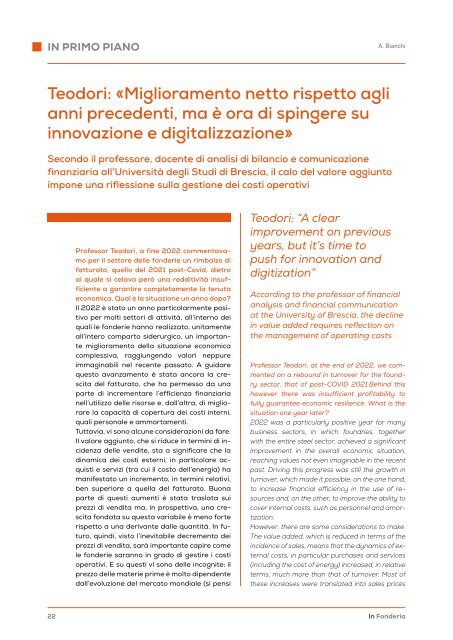In Fonderia 6 2023
Sesto numero del 2023 di In Fonderia
Sesto numero del 2023 di In Fonderia
You also want an ePaper? Increase the reach of your titles
YUMPU automatically turns print PDFs into web optimized ePapers that Google loves.
IN PRIMO PIANO<br />
A. Bianchi<br />
Teodori: «Miglioramento netto rispetto agli<br />
anni precedenti, ma è ora di spingere su<br />
innovazione e digitalizzazione»<br />
Secondo il professore, docente di analisi di bilancio e comunicazione<br />
finanziaria all’Università degli Studi di Brescia, il calo del valore aggiunto<br />
impone una riflessione sulla gestione dei costi operativi<br />
Professor Teodori, a fine 2022 commentavamo<br />
per il settore delle fonderie un rimbalzo di<br />
fatturato, quello del 2021 post-Covid, dietro<br />
al quale si celava però una redditività insufficiente<br />
a garantire completamente la tenuta<br />
economica. Qual è la situazione un anno dopo?<br />
Il 2022 è stato un anno particolarmente positivo<br />
per molti settori di attività, all’interno dei<br />
quali le fonderie hanno realizzato, unitamente<br />
all’intero comparto siderurgico, un importante<br />
miglioramento della situazione economica<br />
complessiva, raggiungendo valori neppure<br />
immaginabili nel recente passato. A guidare<br />
questo avanzamento è stata ancora la crescita<br />
del fatturato, che ha permesso da una<br />
parte di incrementare l’efficienza finanziaria<br />
nell’utilizzo delle risorse e, dall’altra, di migliorare<br />
la capacità di copertura dei costi interni,<br />
quali personale e ammortamenti.<br />
Tuttavia, vi sono alcune considerazioni da fare.<br />
Il valore aggiunto, che si riduce in termini di incidenza<br />
delle vendite, sta a significare che la<br />
dinamica dei costi esterni, in particolare acquisti<br />
e servizi (tra cui il costo dell’energia) ha<br />
manifestato un incremento, in termini relativi,<br />
ben superiore a quella del fatturato. Buona<br />
parte di questi aumenti è stata traslata sui<br />
prezzi di vendita ma, in prospettiva, una crescita<br />
fondata su questa variabile è meno forte<br />
rispetto a una derivante dalle quantità. <strong>In</strong> futuro,<br />
quindi, visto l’inevitabile decremento dei<br />
prezzi di vendita, sarà importante capire come<br />
le fonderie saranno in grado di gestire i costi<br />
operativi. E su questi vi sono delle incognite: il<br />
prezzo delle materie prime è molto dipendente<br />
dall’evoluzione del mercato mondiale (si pensi<br />
Teodori: “A clear<br />
improvement on previous<br />
years, but it’s time to<br />
push for innovation and<br />
digitization”<br />
According to the professor of financial<br />
analysis and financial communication<br />
at the University of Brescia, the decline<br />
in value added requires reflection on<br />
the management of operating costs<br />
Professor Teodori, at the end of 2022, we commented<br />
on a rebound in turnover for the foundry<br />
sector, that of post-COVID 2021.Behind this<br />
however there was insufficient profitability to<br />
fully guarantee economic resilience. What is the<br />
situation one year later?<br />
2022 was a particularly positive year for many<br />
business sectors, in which foundries, together<br />
with the entire steel sector, achieved a significant<br />
improvement in the overall economic situation,<br />
reaching values not even imaginable in the recent<br />
past. Driving this progress was still the growth in<br />
turnover, which made it possible, on the one hand,<br />
to increase financial efficiency in the use of resources<br />
and, on the other, to improve the ability to<br />
cover internal costs, such as personnel and amortization.<br />
However, there are some considerations to make.<br />
The value added, which is reduced in terms of the<br />
incidence of sales, means that the dynamics of external<br />
costs, in particular purchases and services<br />
(including the cost of energy) increased, in relative<br />
terms, much more than that of turnover. Most of<br />
these increases were translated into sales prices<br />
22<br />
<strong>In</strong> <strong>Fonderia</strong>














